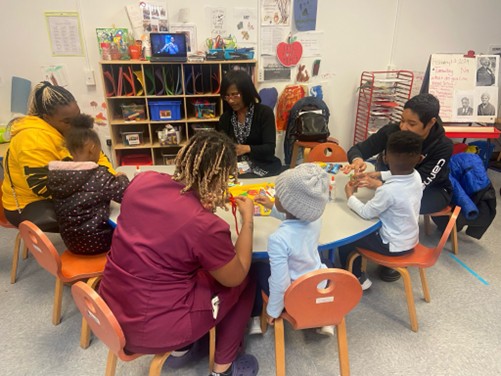Two-way communication and developing family leadership skills are two powerful strategies to engage families. In September, our First 10 Network Meeting focused on starting the year off right with families by offering strategies on effective communication and family leadership development.
First 10 facilitators, Maria Katradis and Jenny Portillo-Nacu, led the meeting and shared communication resources and examples of family leadership initiatives from across the First 10 Network. Participants had opportunities to exchange ideas and strategies with one another throughout the session.
Two-way Communication
Two-way communication involves families and educators working together to support a child’s learning and development. When families and educators have this kind of communication, they both get to share what they know about a child, set goals, and share resources with each other.
To create effective two-way communication, educators and schools should consider family language needs, communication preferences, and accessibility needs. Surveys and conferences are two examples of strategies that can support two-way communication. No matter the method of communication, the most important element is that educators and families balance listening and talking to each other.
Creating Connections through Family Leadership
Creating connections between families can support caregiver mental health and well-being. Families have many stressors, including economic instability, concerns over their children, and isolation and loneliness. The 2024 U.S. Surgeon General’s Advisory on the Mental Health & Well-Being of Parents highlights that approximately 65% of parents and guardians, and 77% of single parents in particular, experience loneliness. Social isolation and lack of social support can lead to heightened stress.
Family mental health can directly affect children’s emotional and cognitive development. If families are feeling stressed or are struggling with their mental and emotional health, children might feel shifts in the emotional climate or consistency of care at home.
One way that schools can support families is by creating opportunities for peer-to-peer connections. Bringing families together through two-generation activities that engage both children and their caregivers at the same time can create positive opportunities for multiple generations to participate in learning.
Another way that schools can support connections between families is through activities that build family leadership. Family leaders are valuable to school communities because they can support other families in accessing resources and provide schools with insight into community assets or needs. Family leaders can also act as advocates for the well-being of their children and themselves, as well as supporting other families and children. An effective leadership program should offer families opportunities to build relationships with others, develop their knowledge and skills, grow their confidence and efficacy, and learn more about advocacy.
Some examples of family leadership activities include families participating in learning sessions to build their skills for supporting their children’s learning at home and serving as cultural liaisons between schools and communities. Schools can also partner with community organizations to offer family leadership development programming. The Sugarland First 10 Partnership in Loudon County, VA partnered with local faith-based organizations to share school messaging with their congregations.
When families are empowered to be leaders, they can engage other families and bring school messaging into the community. Families are often seen as trusted messengers for other families, so they can help increase overall family, school, and community engagement. Families are children’s first and most important teachers, so educators should work to keep them engaged. When families are treated as equal partners in supporting children’s learning, everyone in the community benefits.
